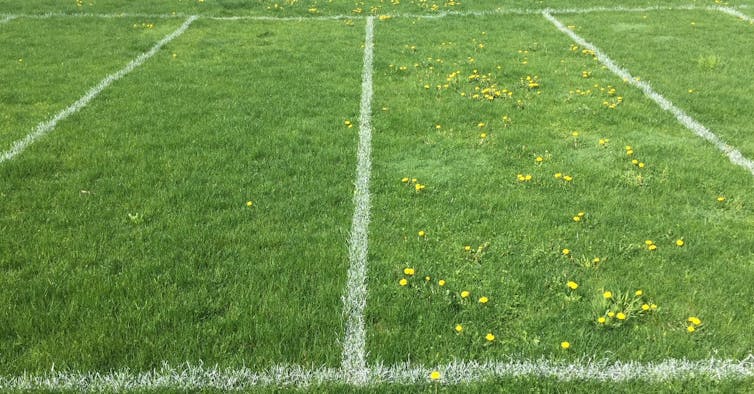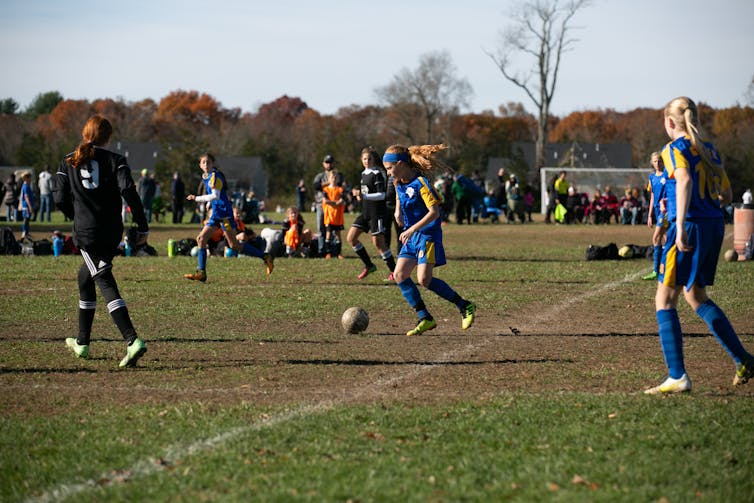Controlling weeds on playing fields, parks and lawns without herbicides
- Written by Jason Henderson, Associate Professor of Turfgrass and Soil Sciences, University of Connecticut
Turfgrass covers more than 40 million acres of land in the continental United States, including lawns, parks, commercial landscapes, sports fields and golf courses. It is the single largest irrigated crop in the nation[1].
Turfgrasses are grass species with qualities that make them well suited for these uses. They tolerate frequent mowing, withstand intense traffic and form dense, uniform surfaces. They create places to play sports or relax outdoors; reduce soil erosion; reduce dust and mud problems around homes, schools and businesses; and create clear sight lines along highways[2].
Often, however, the turfgrass industry is criticized for using significant quantities of water, fertilizer and pesticides. Pesticides have come under especially intense scrutiny as concerns increase over potential health risks.
In many places pesticide legislation has advanced faster than alternative pest control methods. As a researcher specializing in turfgrass and soil sciences[3], I’m interested in new options and have developed a completely new method and tool for turfgrass management that kills weeds without applying chemicals.
 Turfgrass treated mechanically for weeds with the Weedbine (left) and untreated (right).
Jason Henderson, CC BY-ND[4]
Turfgrass treated mechanically for weeds with the Weedbine (left) and untreated (right).
Jason Henderson, CC BY-ND[4]
Herbicides and health
Americans use considerable quantities of herbicides on nonfarmlands, such as lawns, gardens, golf courses, sports fields and public parks. In 2012 such uses accounted for 54 million pounds of herbicide active ingredient[5] – that is, the weed-killing portion of herbicides.
Concerns over pesticides’ potential health impacts have been well publicized in recent years. The American Academy of Pediatrics[6], the Canadian Pediatric Society[7] and other health organizations advise limiting children’s exposure to pesticides both in utero and after birth.
According to these experts, children are most vulnerable to ongoing low-level doses of pesticides because they are growing and developing rapidly, and consume more food and fluids per pound of body weight than adults. They also have more frequent contact with the ground outdoors and floors indoors, and are more likely to ingest residues through frequent hand-to-mouth activity.
In response, Connecticut has banned use of lawn care pesticides on school grounds at public and private pre-kindergarten through eighth-grade schools. New York state has banned pesticide use on school grounds, daycare centers and athletic fields through grade 12. Many U.S. municipalities have banned pesticide use in parks, open space parcels and public rights of way[8][9][10]
Internationally, eight of Canada’s 10 provinces have restricted use of “cosmetic” pesticides[11]. Many cities, states and nations worldwide are banning or restricting sales of glyphosate-based products[12] in response to ongoing concerns about this widely used herbicide’s health effects.
Some communities are hand-weeding parks as an alternative to herbicides, but this strategy is expensive and doesn’t always work.Alternative weed control
Simply mowing correctly, at the proper blade height and frequency, prevents many weeds from establishing and competing with desirable grasses. But some species persist, including dandelion, clover and common plantain, frustrating homeowners and professional turfgrass managers – especially people who choose not to use pesticides or are legally barred from using them.
Controlling weeds in turfgrass is about more than aesthetics, particularly on sports fields. Weeds don’t tolerate foot traffic as well as turfgrasses, so they die first on heavily used surfaces such as athletic fields, leaving bare spots in high-traffic zones. As vegetative cover decreases, surfaces become harder[13], increasing athletes’ risk of injuries[14]. In lawn areas, voids left where weeds die are vulnerable to increased surface runoff and soil erosion.
Current pesticide-free weed control alternatives are very limited, largely ineffective and expensive, or have undesirable side effects. For example, iron-based alternative herbicides can drastically – although temporarily – darken turfgrass, which is an issue in settings such as lawns, gardens and parks. Repeat applications are also often required.
In our research, we have found that aggressively overseeding – applying grass seed over an existing field at high rates – is the most effective way to significantly reduce weeds on sports fields[15]. But this approach does little for well-established, mature weeds, and it has minimal effectiveness in low-traffic portions of the playing surface.
 Weeds on turf fields are damaged faster than the grass, which leads to bare spots and soil compaction and can increase injury risks for athletes.
Gina Henderson, CC BY-ND[16]
Weeds on turf fields are damaged faster than the grass, which leads to bare spots and soil compaction and can increase injury risks for athletes.
Gina Henderson, CC BY-ND[16]
A new approach
Instead of cutting grass with rotating blades like a mower, the device I am developing, the Weedbine, pulls turfgrasses and weeds through a sieve-like metal device. Turfgrasses have slender, resilient leaf blades, but broadleaf weeds have larger, thicker leaves, which are either pulled off or badly damaged as the device passes over them. Once a weed’s leaf tissue is damaged, it has little or no ability to absorb the Sun’s energy and produce carbohydrates.
The Weedbine works by physically damaging the leaves of broadleaf weeds, preventing the plants from photosynthesizing and growing.The Weedbine is designed to be used routinely – say, once a week, either before or at the same time that turfgrass fields are mowed. This will ensure that as soon as damaged weeds produce new leaf tissue, it will be damaged or removed again in another round of treatment. The weeds thus have to continually rely on carbohydrate reserves in their root system for regrowth, and eventually will use up these stores and die.
Using the Weedbine weekly immediately reduces weed cover, but more mature weeds will recover week to week. Many factors influence how long it takes to achieve control, including turfgrass quality, soil quality, weed species, and weed maturity and density.
Results show that selective mechanical weed control is very effective when used weekly for common turfgrass weeds such as dandelion, as well as traditionally hard-to-control weeds such as clover and ground ivy. Many homeowners and groundskeepers already mow routinely and can easily be trained to use a Weedbine.
As we progress toward commercialization, we are assessing ways to integrate the Weedbine with a mower to meet the needs of professional turfgrass managers and homeowners. Our goal is to provide effective, reliable weed control for people who choose not to use herbicides, are legally forbidden from using them or want to expand their current strategies for minimizing pesticide use.
[ You’re smart and curious about the world. So are The Conversation’s authors and editors. You can read us daily by subscribing to our newsletter[17]. ]
References
- ^ single largest irrigated crop in the nation (www.isprs.org)
- ^ create clear sight lines along highways (www.turfresearch.org)
- ^ researcher specializing in turfgrass and soil sciences (www.researchgate.net)
- ^ CC BY-ND (creativecommons.org)
- ^ 54 million pounds of herbicide active ingredient (www.epa.gov)
- ^ American Academy of Pediatrics (www.aap.org)
- ^ Canadian Pediatric Society (www.ncbi.nlm.nih.gov)
- ^ banned use of lawn care pesticides on school grounds (www.cga.ct.gov)
- ^ school grounds, daycare centers and athletic fields (www.dec.ny.gov)
- ^ parks, open space parcels and public rights of way (www.nontoxiccommunities.com)
- ^ eight of Canada’s 10 provinces have restricted use of “cosmetic” pesticides (www.beyondpesticides.org)
- ^ glyphosate-based products (www.baumhedlundlaw.com)
- ^ surfaces become harder (dl.sciencesocieties.org)
- ^ athletes’ risk of injuries (doi.org)
- ^ reduce weeds on sports fields (agris.fao.org)
- ^ CC BY-ND (creativecommons.org)
- ^ You can read us daily by subscribing to our newsletter (theconversation.com)
Authors: Jason Henderson, Associate Professor of Turfgrass and Soil Sciences, University of Connecticut

